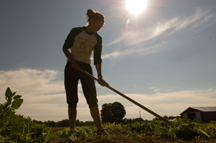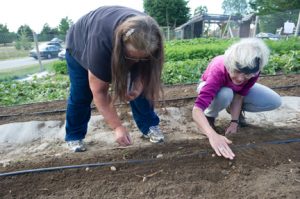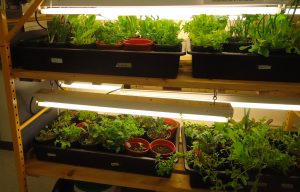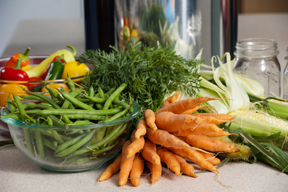Maine Home Garden News — April 2014
- April Is the Month to . . .
- Selecting Your Garden Tools Depending on the Job at Hand
- Donation Gardens
- Planting in Jackman
- Food and Nutrition: Storing and Preparing Homegrown Vegetables for Optimal Nutrition
By Rick Kersbergen, Extension Educator, University of Maine Cooperative Extension Waldo County
- If you start your own seeds, make sure you use clean containers, especially if you re-use the containers from last year. Clean plant containers with one part bleach to nine parts water solution to prevent disease transmission from old containers.
- Check your fruit trees and apply dormant oil before the fruit buds begin to swell.
- Plan your seed-starting regime and develop a planting schedule so your seedlings will not be too big before they can go outside without a danger of frost. For more information, see Bulletin #2751, Starting Seeds At Home.
- Inspect trees and shrubs in your landscape and prune out any damaged or dying branches. Use sharp pruning tools. Wear eye protection. See Bulletin #2169, Pruning Woody Landscape Plants for more information.
- Prune blueberries or raspberries. Watch our “how to” videos for tips and techniques:
- Get your rototiller and lawnmower serviced so they will be ready to go when spring arrives.
- Get a soil test as soon as the ground thaws, if you didn’t do one last fall. Send soil samples to the University of Maine Analytical Lab. When you receive the soil test report, plan to amend the garden as recommended. The cost of a test is $15. Get your form online or visit your local Extension office for a form and mailer box. For more information about testing your soil, see Bulletin #2286, Testing Your Soil.
- Till only when soil is dry enough. Tilling wet soil will ruin the soil structure for the rest of the summer! If you make a tight ball with a handful of soil and it doesn’t fall apart when you open your fist, then it is too wet! Once you have tilled your garden, some of the first vegetables that can be planted include peas, lettuce, and spinach.
- Plant some frost tolerant crops by seed or transplant as soon as the soil is workable. Some choices would be broccoli, cabbage by transplant, and endive, lettuce, pea, radish, spinach, and turnip by seed.
- You can’t be a gardener in Maine without thinking about how to extend the garden season. Start now: see Bulletin #2752, Extending the Gardening Season.
Selecting Your Garden Tools Depending on the Job at Hand
By Diana Hibbard, Home Horticulture Coordinator, University of Maine Cooperative Extension Cumberland County
 Buying the best tool you can afford makes a lot of sense. The initial cost may seem high, but quality is usually worth the investment. In general, look for tools that are forged (one piece) versus welded; avoid cast. Are you purchasing a tool for regular use? Is it comfortable to use? Does it fit your hand size? Is it strong enough for continuous use? Tools are crafted for specific jobs and should be used for that task to avoid breakage and personal injury.
Buying the best tool you can afford makes a lot of sense. The initial cost may seem high, but quality is usually worth the investment. In general, look for tools that are forged (one piece) versus welded; avoid cast. Are you purchasing a tool for regular use? Is it comfortable to use? Does it fit your hand size? Is it strong enough for continuous use? Tools are crafted for specific jobs and should be used for that task to avoid breakage and personal injury.
A list of tools a gardener or homeowner might want to have on hand include:
- A garden fork, spade, rake, hoe, trowel
- A leaf rake (both traditional size and one that collapses to access leaves under shrubs)
- You may also want bypass hand pruners and loppers.
- A wheelbarrow for moving soil, mulch, plants or supplies around your property
There are many places, locally and online, where you can purchase garden tools. If you are part of a community garden or could visit one this spring, see what other gardeners are using and recommending. I value tools that belonged to my grandfather. They are a special part of my gardening routine.
Once you have acquired your tools, make sure you maintain them properly so they will last and can be passed down to your grandchildren. Rinse and dry them after each use. At least once a year, clean with a wire brush and lubricate the metal parts with a biodegradable oil. Also, wipe the wooden handles with a penetrating oil like linseed oil to prevent splitting. Pay particular attention to the area where the metal and handle come together. In any case, avoid used engine oil even if your grandfather used to do it that way. Times have changed. Hopefully, we are more in tune with our environment.
It’s important to keep your tools out of the elements when they are not being used. Hanging your tools is the best way to keep them organized. There are lots of tool organizers you can buy at your hardware store, or you can drill 1/4-inch holes in the handles and hang them on a ten-penny finish nail driven into a handy 2×4. Your tool will be there waiting for your next gardening task. Most importantly, the cleaning of your garden tools can help keep disease, fungi, insect eggs, and weed seeds from being spread around your garden.
Hand pruners benefit from a quick soap and water wash with a nailbrush or scrubbing pad to prevent spreading disease. Dry well and add a drop or two of lubrication to only the pivot point. I like to use a drop of 3-in-One oil.
You may want to invest some time in sharpening your tools. A sharp tool is much safer to use and gets the job done much more quickly. If you don’t feel confident sharpening, there are professionals who can do this for you. Often the University of Maine Cooperative Extension will offer a class that shows the steps and takes the mystery out of keeping the edges of your favorite tools ready to do their very best work.
Donation Gardens
By Barbara Murphy, Extension Educator, University of Maine Cooperative Extension Oxford County, barbara.murphy@maine.edu
 Planning a garden to donate some or all of the harvest is a bit different than planning a garden for personal use. Here are some suggestions for your consideration when planning a garden with food donation as a purpose.
Planning a garden to donate some or all of the harvest is a bit different than planning a garden for personal use. Here are some suggestions for your consideration when planning a garden with food donation as a purpose.
- All donated produce should be of high quality, clean, not over-grown, blemished, damaged or diseased.
- Ideally it is better to plan to donate rather than donating what you have left over. Very small quantities of produce are difficult to distribute to a large crowd.
- Contact the organization(s) to which you plan to donate.
- Note: If you need help in identifying organizations in your area, go to the Maine Harvest for Hunger website and click on Donate Produce. There you will find a link to food assistance programs by town.
- Determine if the organization is able to use fresh produce, and if so what would they like you to grow.
- Determine how much and how frequently they accept deliveries, for example, 10 pounds of beans every other Tuesday. Some food pantries are open on specific days of the week.
- Determine how they would like the produce delivered (cleaned, bunched, bagged, loose).
- Remember, some, (but not all), of the clientele may not be familiar with many different types of produce and the volunteers may not have the time to educate people on how to use an unfamiliar vegetable. So, stick with the tried and true. Our experience with the Maine Harvest for Hunger distribution lines has shown that heirloom tomatoes, fresh herbs other than basil and dill, Asian greens, and non-standard colored beets and carrots are less preferred than standard varieties.
- Weigh (or guesstimate) the produce before donating and report it to your local Maine Harvest for Hunger coordinator. Or, you can report it online at the Maine Harvest for Hunger Donate Produce web page.
- Thank you for considering a donation garden this growing season. Fresh produce is always in demand and is much too valuable to go to waste.
Planting in Jackman
By Brenda Seekins, Master Gardener Volunteer, Somerset County

Joe Bergeron has a passion for food, preparing it and growing it. He firmly believes that people not only need to know how to prepare fresh food, but they need to know how to grow it. He and his partner Danielle Hale, both Master Gardener Volunteers, are doing their part in Jackman, working with school children and the community.
“This year, my third graders — last year’s second graders — they remembered a lot of what they learned last year. They know their stuff when it comes to planting and harvesting,” Joe said in a phone interview recently.
It didn’t start with teaching, but rather a website he started in 2011 to share his knowledge of food and particularly fresh food.
“I woke up one night with an idea and wrote 10 pages for a website (www.thelazyjway.com) over the next three days. It was everything from gardening to food. I’d never done it before.”
He’s still doing it and expanded to Facebook (www.facebook.com/thelazyjwaycom), but now it’s more about what’s happening with third and fourth graders at the Forest Hills Consolidated School (K-12) in Jackman.
The fourth grade classroom has a growing rack and the third grade wants one for next year. The school has a potatoes and onion garden; the children participate in a potato and pole bean planting project. There’s a garden growing in the library window and there have already been five separate harvests…and it’s all green and fresh!
“I’ve never taught before, but Danielle came home from a meeting talking about how bad the food was in the cafeteria (a lot of prepared foods) and I sort of fell into it,” he said.
Joe is teaching two classes how to plant, to harvest, and then how to use the food produced for healthy snacks and meals. Gardening topics and activities are incorporated into classroom instruction.
“We reached 20 families in the second year and we expect to reach 30 this year,” he said of the results of his now three-year project, teaching and coaching children about fresh foods and healthy living. He and Danielle as “Farmer Joe and Farmer Danielle” are part of the Let’s Go program sponsored by the Harvard Pilgrim Foundation. It’s a program under the label “5-2-1-0” (Five vegetable or fruits, two hours of recreational “screen time,” one hour of physical activity and “0” sugary drinks daily). There are over 1,000 sites statewide promoting a healthy lifestyle. The Jackman (Let’s Go with Farmer Joe) program was featured in the 5-2-1-0 Annual Report for 2013.
“But just 14 of those are in Somerset County,” Joe said. “I enjoy going to school and hearing the kids tell me what they’re doing at home with gardening.”
With Joe teaching, planting, and posting to the web, Danielle has taken on the school greenhouse project and growing food for the cafeteria, but she also is “planting the town” — literally taking on any available growing space that people will let her plant. The harvest from those gardens helps elderly residents and younger families in need of fresh food.
Joe is not “just a gardener” — he is a trained chef through Johnson and Wales University, a school known for culinary arts. Armed with his varied experience and Master Gardener training, Joe is hoping to reach a younger generation with the goodness and healthy habits born of homegrown food.
“Fortunately the culinary industry is catching on,” he said. “It’s basic economics. I don’t see it going any other way. You can’t continue to grow when you’re taking away the land with development. I firmly believe they (the children) are going to need this…to know how to grow their own food.”
Food and Nutrition
 Storing and Preparing Homegrown Vegetables for Optimal Nutrition
Storing and Preparing Homegrown Vegetables for Optimal Nutrition
By Kate Yerxa, MS, RD, University of Maine Cooperative Extension
Many factors contribute to the vitamin and mineral content of homegrown vegetables. Soil health affects the nutrient profile of the vegetables. But just as important in maintaining the vitamin and mineral content, is the cooking and storage methods used for these vegetables.
Storage
The question about whether to wash or not wash vegetables before storing is a common question. You may worry that not washing will bring dirt into your kitchen, but it is actually best to not wash vegetables prior to storage, as washing may cause the vegetables to rot.
- When storing without washing, rub or brush off any garden dirt with a paper towel or soft brush.
- For vegetables that need refrigeration, they should be stored at 40°F or less.
- If your refrigerator has a fruit and vegetable bin, use that, and be sure to store fresh produce away from raw meats, poultry or fish.
- Store fresh produce in plastic bags or containers in the refrigerator so they don’t contaminate other foods.
Cooking
Eating fruits and vegetables is key in losing weight and preventing weight gain, and reducing the risk of certain chronic diseases. There is conflicting information about whether fruits and vegetables should be eaten raw or cooked. But, there are some nutrients, like water-soluble vitamins (vitamin C and folate), which can be destroyed during prolonged cooking. There are also some nutrients and phytochemicals that are more available when cooked, such as lycopene, a phytochemical from tomatoes.
Cooking methods that take less time and use less water tend to retain more water-soluble vitamins. These cooking methods include microwaving, steaming, sautéing and pressure-cooking.
No one cooking method should be considered the only way to prepare and cook vegetables; instead, use a variety of cooking methods to prepare meals, including eating vegetables raw.
Preserving
Produce not eaten right away should be preserved for later use. A researcher at the University of Georgia found that freezing specific vegetables and fruits after harvest preserved more vitamin A, C, and folate than storing in the refrigerator and eating after five days.1 The sooner you eat harvested vegetables, the less chance of vitamin loss. Freezing is an easy way to preserve vegetables. For more information about freezing vegetables, see UMaine Extension Bulletin #4384, Freezing Vegetables.
Home gardens are an excellent way to increase the availability of vegetables in your household. When you are planning your garden, remember that, in general, the more colorful the vegetables you plant, more vitamins and minerals they contain.
For recipes and more information about preparing Maine vegetables, check out UMaine Extension fact sheet series Vegetables and Fruits for Health.
Source:
1UGA study uses consumer behavior to determine whether fresh or frozen produce contain more nutrients. December 2013. Available at: http://www.caes.uga.edu/applications/gafaces/?public=viewStory&pk_id=4966.
University of Maine Cooperative Extension’s Maine Home Garden News is designed to equip home gardeners with practical, timely information.
Let us know if you would like to be notified when new issues are posted. To receive e-mail notifications fill out our online form.
Contact Lois Elwell at lois.elwell@maine.edu or 1.800.287.1471 (in Maine).
Visit our Archives to see past issues.
Maine Home Garden News was created in response to a continued increase in requests for information on gardening and includes timely and seasonal tips, as well as research-based articles on all aspects of gardening. Articles are written by UMaine Extension specialists, educators, and horticulture professionals, as well as Master Gardener Volunteers from around Maine, with Professor Richard Brzozowski serving as editor.
Information in this publication is provided purely for educational purposes. No responsibility is assumed for any problems associated with the use of products or services mentioned. No endorsement of products or companies is intended, nor is criticism of unnamed products or companies implied.
© 2014
Call 800.287.0274 or TDD 800.287.8957 (in Maine), or 207.581.3188, for information on publications and program offerings from University of Maine Cooperative Extension, or visit extension.umaine.edu.
